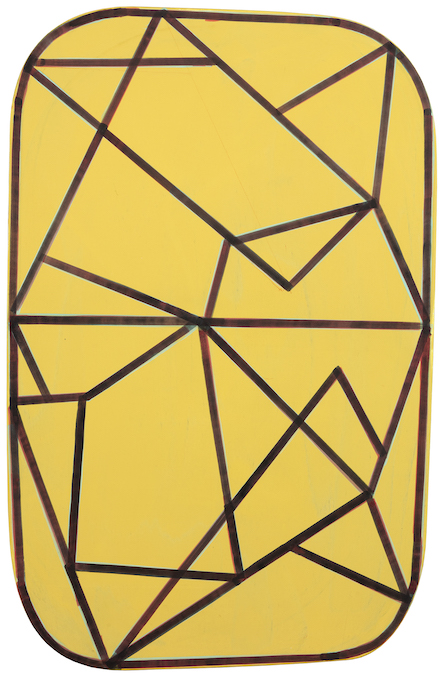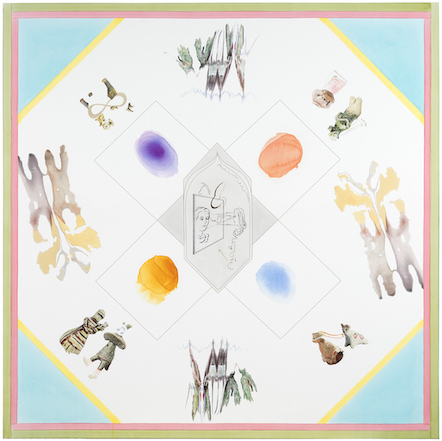
As the final exhibition of 2019 Helsinki Contemporary has the pleasure to present Hidden matter, a duo show with Mikko Hintz and Inga Meldere. The artists have worked in parallel with new works, under the same title but still creating two independent series of works.
Mikko Hintz works with abstract painting. His new works explore the relationship of form, colour and the painterly process. Hintz has found interesting shapes in surfboards and sails, shields and kites and other everyday objects and has created the outlines for his interpretation of these in custom-built stretchers. Some composition give hints towards the original use and structure of the shapes, the mood and character of a given form leads the painting itself. One could read the works both as painted objects or sculpted paintings, they exist in and communicate strongly with the surrounding space.
The works are reminiscent of abstract expressionism and colour field painting, and the shaped surfaces create a sculptural character. The act of painting is a negotiation between the painterly gesture and the given shape of the painting. Hintz’s works challenge the common ideas of perception and encourage different ways of viewing and experiencing painting.
Mikko Hintz (b.1974 Waiblingen i. R., Germany) is a German-born Finnish artist, who lives and works in Helsinki. He has studied at the Academy of Fine Arts in Helsinki and Royal Danish Academy of Fine Arts in Copenhagen. Hintz is represented in public collections such as Museum of Contemporary Art Kiasma, HAM Helsinki Art Museum,The Collection of Finnish State Art Commission and Frieder Burda Collection in Baden Baden. Hintz has exhibited widely in Finland and Europe and recent shows include Temnikova & Kasela gallery, Tallinn (2016); Kiasma Museum of Contemporary Art, Helsinki (2013–2014) and Kalnciema Quartier gallery, Riga (2012). The exhibition is supported by The Finnish Cultural Foundation.
Work: Inga Meldere
Photo: Jussi Tiainen
Inga Meldere starts her artistic process with research. By diving into stories and art history she finds such an abundance of material that each finished work could be a starting point to a new exhibition. One could say that her paintings are a combination of research both outside and inside the studio. Meldere is also interested in ways of painting and ways of perception, how the mind and reason interact with the senses, the realm of the body.
For this exhbition, Meldere studied the relationship between Henri Matisse and his model and long time muse, Lydia. This functioned as one entry point to the subject of caring. Questions of how we care, what are the power structures lying behind these acts, and what are the tools in acts of caring have been central. Lydia was not just a model, but also a studio assistant and life partner until the end of Matisses’ life. Meldere draws attention to emancipation, gender equality and feminine symbols in our society. Through introducing the visual element of a scarf - a feminine accessory and symbol of social status - she addresses these matters, but also uses the symmetry of the scarf design as a tool for the composition of the painting.
Meldere’s works are combinations of printing and painting. The UV-printing is often a link to the archival material she encounters while researching. The finished work is always a carefully balanced, delicate and refined painting.
Inga Meldere (b. 1979, Kuldiga, Latvia) lives and works in Helsinki. She studied at the University of Latvia and at the Art Academy of Latvia. Meldere was a researcher at Jan Van Eyck Academie in Maastricht 2013-2014. She is currently attending a MA program in Painting at the University of the Arts in Helsinki.
Meldere’s recent solo and duo exhibitions include shows at Latvian National Museum of Art, Riga (2017); SIC, Helsinki (2017); kim? Contemporary Art Centre, Riga (2016); Temnikova & Kasela gallery, Tallinn (2016). She has participated in various group exhibitions at eg. Museum of Contemporary Art Kiasma, Helsinki, Finland (2018 -2019); Exhibition hall Arsenals, National Museum of Latvia, Riga (2017); Barbara Seiler Gallery, Zürich (2016–2017). Meldere is represented in the collection of Museum of Contemporary Art Kiasma, The Collection of Finnish State Art Commission, and private collections such as HANGart (Vienna Austria), bta art (Vienna Insurance Group), Janis Zuzans and Maris Vitols collections. TAIKE and The Finnish Cultural Foundation have supported the exhibition.
Helsinki Contemporarylla on ilo päättää vuosi 2019 Mikko Hintzin ja Inga Melderen yhteisnäyttelyyn Hidden matter. Taiteilijat ovat työskennelleet uusien teostensa parissa rinnakkain ja saman näyttelyn nimen alla, mutta luoneet silti kaksi itsenäistä teoskokonaisuutta.
Mikko Hintz työskentelee abstraktin maalauksen parissa. Hänen uudet teoksensa tutkivat muodon, värin ja maalausprosessin välisiä suhteita. Hintz on löytänyt kiinnostavia muotoja surffilaudoista ja purjeista, kilvistä, leijoista sekä muista arkisista objekteista, ja luonut niistä tulkintojensa ääriviivat erikoisvalmisteisiin maalauspohjiin. Jotkin kompositioista vihjaavat teosten muotojen alkuperään, kunkin muodon tunnelma ja luonne ohjaa itse maalausta. Teoksia voi lukea sekä maalattuina objekteina että veistettyinä maalauksina, jotka vaikuttavat ja kommunikoivat vahvasti ympäröivän tilan kanssa.
Hintzin teokset muistuttavat abstraktista ekpressionismista ja värikenttämaalauksesta, muotoillut pinnat luovat teoksille veistosmaisen luonteen. Maalaustapahtuma on neuvottelua maalauksen teon ja teokselle annetun muodon välillä. Hintzin teokset haastavat totutut käsitykset havainnosta ja rohkaisevat löytämään eri tapoja maalauksen katsomiseksi ja kokemiseksi.
Mikko Hintz (s. 1974 Waiblingen, Saksa) asuu ja työskentelee Helsingissä. Hän on opiskellut Kuvataideakatemiassa Helsingissä sekä Tanskan kuninkaallisessa taideakatemiassa Kööpenhaminassa. Hintzin teoksia sisältyy mm. Kiasman ja HAMin kokoelmiin. Hän on esiintynyt useissa näyttelyissä niin Suomessa kuin muualla Euroopassakin, viimeaikoina mm. Temnikova & Kasela galleryssa Tallinnassa 2016, Kiasmassa Helsingissä 2013-2014 sekä Kalnciema Quartier galleryssa Riiassa 2012. Suomen Kulttuurirahasto on tukenut näyttelyä.

Teos: Inga Meldere
Kuva: Jussi Tiainen
Inga Melderen työskentelyprosessi alkaa tutkimuksella. Sukeltaessaan tarinoiden maailmaan ja taidehistoriaan hän löytää sellaisia määriä materiaalia, että jokainen valmis teos voisi toimia lähtökohtana omalle näyttelylleen. Melderen teokset muodostuvat yhdistelmästä työhuoneen ulko- ja sisäpuolella tehtyä tutkimusta, hän on kiinnostunut myös maalaamisen sekä havainnoinnin tavoista – siitä, miten järki ja mieli ovat vuorovaikutuksessa aistien ja kehon maailman kanssa.
Uutta näyttelyä varten Meldere on tutkinut Henri Matissen ja tämän pitkäaikaisen mallin ja muusan Lydian suhdetta. Tutkimus on toiminut yhtenä väylänä hoivan ja huolenpidon aiheeseen. Keskeisiksi ovat nousseet kysymykset hoivaamisen tavoista, hoivan tekojen sisältämistä voimasuhteista sekä käytössämme olevista hoivaamisen välineistä. Lydia ei ollut ainoastaan malli, vaan myös Matissen assistentti ja elämänkumppani taiteilijan elämän loppuun saakka. Meldere kiinnittää huomion emansipaatioon, sukupuolten tasa-arvoon sekä naisellisiksi miellettyihin symboleihin yhteiskunnassamme. Hän käsittelee aiheitaan tuomalla teoksiinsa huivin visuaalisena elementtinä – naisellisen asusteen ja sosiaalisen statuksen symbolin – ja käyttää huivien kuvioiden symmetriaa myös maalaustensa kompositioiden välineinä.
Melderen teokset yhdistelevät maalausta ja UV-painotekniikkaa, johon liittyy usein taiteilijan tutkimuksissaan kohtaamaan arkistomateriaaliin. Valmis teos on aina huolellisen tasapainoinen, herkkä ja hienostunut maalaus.
Inga Meldere (s. 1979 Kuldiga, Latvia) asuu ja työskentelee Helsingissä. Hän on opiskellut Latvian yliopistossa ja Latvian taideakatemiassa, sekä toiminut tutkijana Jan Van Eyck -akatemiassa vuosina 2013-2014. Tällä hetkellä Meldere opiskelee Helsingissä, Taideyliopiston Kuvataideakatemian maalaustaiteen maisteriohjelmassa. Hänen viimeisimmät yksityisnäyttelynsä on nähty Latvian kansallisessa taidemuseossa Riiassa 2017, galleria SICssä Helsingissä 2017, kim? Contemporary Art Centerissä Riiassa 2016 ja Temnikova & Kasela galleryssa Tallinnassa 2016. Meldere on esiintynyt laajasti ryhmänäyttelyissä kansainvälisesti, viimeisimpänä Kiasmassa 2018 -2019, Exhibition hall Arsenalsissa, sekä Barbara Seiler Galleryssa Zürichissä 2016–2017. Melderen teoksia sisältyy Kiasman kokoelmaan ja Valtion taideteostoimikunnan kokoelmaan, sekä yksityisiin kokoelmiin kuten HANGartin (Wien, Itävalta), bta artin (Vienna insurance group) sekä Janis Zuzansin ja Maris Vitolsin kokoelmiin. TAIKE ja Suomen Kulttuurirahasto ovat tukeneet näyttelyä. Taiteilija kiittää Agnese Krivadea yhteistyöstä ja tuesta.
Helsinki Contemporary har glädjen att avsluta året 2019 med Mikko Hintz och Inga Melderes gemensamma utställning Hidden matter. Konstnärerna har arbetat tillsammans med sina nya verk under ett gemensamt utställningsnamn samtidigt som de ändå har skapat två självständiga helheter.
Mikko Hintz arbetar med abstrakt måleri. Hans nya verk studerar relationerna mellan form, färg och själva målarprocessen. Hintz har hittat intressanta former i surfbrädor och segel och i sköldar, drakar och andra vardagliga objekt och låtit dem fungera som konturer för sina tolkningar på specialtillverkade underlag. Vissa kompositioner anspelar på de varierande formernas ursprung, och de enskilda formernas stämning och karaktär styr själva målningen. Verken kan läsas både som målade objekt och som skulpterade målningar som starkt påverkar och kommunicerar med det omgivande rummet.
Hintz verk för tankarna till den abstrakta expressionismen och färgfältsmåleriet, de formade ytorna ger verken en skulptural karaktär. Målandet är en överläggning mellan själva arbetsprocessen och den form verket getts. Hintz verk utmanar våra invanda uppfattningar om perception och lockar oss att söka olika sätt att betrakta och uppleva en målning.
Mikko Hintz (f. 1974 i Waiblingen, Tyskland) bor och är verksam i Helsingfors. Han har studerat vid Bildkonstakademin i Helsingfors och vid Det Kongelige Danske Kunstakademi i Köpenhamn. Hans verk ingår i bl.a. Kiasmas och HAMs samlingar. Hintz verk har visats på talrika utställningar såväl i Finland som i andra europeiska länder, under senaste tid bl.a. på galleri Temnikova & Kasela i Tallinn 2016, Kiasma i Helsingfors 2013–2014 samt galleri Kalnciema Quartier i Riga 2012. Utställningen har understötts av Suomen Kulttuurirahasto.

Verk: Inga Meldere
Bild: Jussi Tiainen
Inga Meldere inleder sin arbetsprocess med research. Hon dyker ner i berättelsernas värld och konstens historia och hittar så mycket material att varje färdigt verk kunde fungera som utgångspunkt för en egen utställning. Melderes verk bygger på en kombination av reaserch både i och utanför ateljén, hon är också intresserad av olika sätt att måla och varsebli – av hur förnuftet och psyket står i växelverkan med sinnenas och kroppens värld.
Inför den nya utställningen har Meldere studerat förhållandet mellan Henri Matisse och Lydia, hans långvariga modell och musa. Detta kom att bli en kanal som förde Meldere i riktning mot temat vård och omvårdnad. Centrala frågor har då varit omvårdnadens konkreta metoder, styrkeförhållandena i de konkreta vårdhandlingarna samt de redskap vi har för omvårdnad. Lydia var inte enbart en modell utan också Matisses assistent och livskamrat ända till hans död. Meldere fokuserar på emancipation, jämställdhet mellan könen och sådana symboler som i vårt samhälle uppfattas som feminina. Hon behandlar sina motiv genom att introducera scarfen – ett kvinnligt plagg och en social statussymbol – som ett visuellt element i sina verk, och hon använder också symmetrin i scarfarnas bildmönster som ett verktyg i sina kompositioner.
Melderes verk kombinerar måleri och UV-tryckteknik, ofta med kopplingar till arkivmaterial hon stött på i sin research. Det färdiga verket är alltid en omsorgsfullt balanserad, lika känslig som förfinad målning.
Inga Meldere (f. 1979 i Kuldiga, Lettland) bor och är verksam i Helsingfors. Hon har studerat vid Lettlands universitet och Lettlands konstakademi och arbetade 2013–2014 som forskare vid Jan van Eyck Academie i Maastricht. För närvarande studerar hon inom magisterprogrammet för måleri vid Konstuniversitetets Bildkonstakademi i Helsingfors. Senast hade hon separatutställningar på Lettlands nationella konstmuseum i Riga 2017, galleri SIC i Helsingfors 2017, kim? Contemporary Art Center i Riga 2016 och galleri Temnikova & Kasela i Tallinn 2016. Hon har också deltagit i många grupputställningar i olika länder, senast på Kiasma 2018–2019, Arsenalens konsthall i Riga samt Barbara Seiler Gallery i Zürich 2016–2017. Melderes verk ingår i Kiasmas och Statens konstverkskommissions samlingar samt i privata samlingar, däribland HANGarts (Wien), bta arts (Vienna Insurance Group) och Janis Zuzans och Maris Vitols samlingar. Utställningen har understötts av TAIKE och Suomen Kulttuurirahasto. The artist would like to thank Agnese Krivade for her support and collaboration.
Share this exhibition